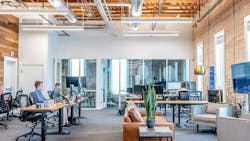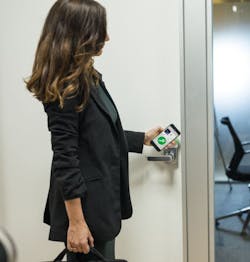Unlocking Sustainability: Smart Access in the Coworking Space
Welcome to the future of coworking and office spaces, where smart access technologies are not only enhancing security but also championing sustainability. Imagine a world where getting into your office is as easy as a tap on your phone and just as eco-friendly. That's the magic of modern smart access systems—they're revolutionizing how we manage our spaces and resources, all while giving Mother Earth a big high-five.
What is Smart Access?
So, what exactly do I mean when I say “smart access”? Picture this: no more fumbling for keys or worrying about losing them, or worse, them being copied or stolen. Smart access uses advanced tech like biometric scanners, RFID cards, and mobile apps to control entry and access to buildings, offices, meeting spaces, even lockers. It's like having a personal doorman who knows you by face… or, by your smartphone. These systems solve many of the headaches coworking operators have struggled with for years, from unauthorized access to the chaos and expense of lost keys.
Some Examples:
- RFID Cards: Most people today are familiar with this technology as it is widely used everywhere from hotels to apartment buildings. Just hold a card, which holds encrypted data about the user, near a reader to access various parts of the building without a physical key.
- Mobile Apps: My unofficial estimate is that 99.99999% of today’s coworking users carry a smartphone with them at all times. So, why not make the smartphone the access credential? Access the building, unlock doors, even send temporary access to visitors all from your smartphone—it’s super convenient and contactless.
- Biometric Scanners: It’s not science fiction anymore. Use your unique physical traits, like fingerprints or facial recognition, to get in.
The Tech-Sustainability Relationship
You might wonder, how building tech ties into sustainability? Well, smart access systems are a great example. They help optimize resource use, cut down on waste, and save energy. By integrating these systems, we can create more efficient, eco-friendly environments that are kinder to our planet and help your coworking.
Why is Sustainability Important in Coworking?
Sustainability might feel like a buzzword these days, but what does it really mean for coworking and flexible workspaces? In a coworking environment, it means everything from cutting down carbon emissions to choosing eco-friendly suppliers for construction and design. It's about making choices that are good for both the planet and the people using the spaces.
You can’t overstate the importance of going green in the office. One government study showed that commercial buildings are responsible for about 10% of greenhouse gas emissions and a whopping 24% of total electricity use. Coworking space providers have a golden opportunity to set the standard for sustainable practices. As more individuals and employers look for eco-friendly workspaces, those who don’t prioritize sustainability might find themselves lagging behind the competition.
The benefits of sustainable workspaces go beyond just helping the environment. For one, going green can slash operating costs and boost profits. By adopting energy-efficient systems, coworking operators can lower their utility bills and reduce their carbon footprint. It is a win-win for the planet and the bottom line. A “green” workspace isn’t just a trend; it’s a necessity for our future.
What Makes a “Green” Office?
- Green Building Design: Sustainable construction and operation practices reduce environmental impact.
- Energy Efficiency: Use energy-saving lighting, heating, and cooling systems.
- Shared Resources: From energy-hungry appliances to printers and copy machines, sharing resources means we need fewer of them.
- Waste Reduction: Set up recycling programs and cut down on single-use plastics.
- Sustainable Materials: Opt for furniture and supplies made from recycled or sustainable materials.
- Alternative Transportation: Additional efforts to reduce carbon emissions include spaces encouraging and incentivizing sustainable commuting like taking public transit or biking to work.
- Good Air Quality: Ensure proper ventilation and use low-VOC paints and finishes.
How Smart Access Reduces Energy Consumption
Smart access systems are brilliant at conserving energy. They can sync with building management systems to control lighting and HVAC based on occupancy. Imagine lights and air conditioning that turn off automatically when no one’s in the room – that’s smart access at work, saving energy and cutting costs.
Better Security Measures and Their Green Impact
Enhanced security with smart access systems has some green perks too. Traditional security methods, like physical locks and keys, often need regular replacements, creating waste. Smart access systems, managed digitally, reduce the need for physical hardware and cut down on material waste.
Green Benefits of Smart Security:
- Less Reliance on Physical Locks and Keys: Reduces the production and disposal of these items.
- Minimal Waste: Fewer key replacements and system upgrades mean less waste.
- Efficient Resource Use: Track usage patterns to optimize energy use – like knowing when to turn off lights or power down rooms.
Choosing a Sustainable Access Control Manufacturer
When it comes to sustainability, it's not just about what your company does; it's also about the partners and vendors you choose. Selecting an access control manufacturer with a strong commitment to environmental responsibility can amplify your green efforts.
Many access control manufacturers themselves have struggled with adopting sustainable practices. I am proud to say my company, Salto and our entire Salto Wecosystem group of companies have been ahead of the green curve, and today, sustainably is part of our DNA.
Examples & Benefits of a Sustainable Manufacturer:
- Zero-CO2 Factory: A manufacturer with a Zero-CO2 Factory ensures that their production processes do not contribute to carbon emissions, aligning with global goals to reduce greenhouse gases.
- Sustainable Manufacturing Processes: Utilizing processes that minimize waste and energy consumption ensures that the environmental footprint of production is kept as low as possible.
- 100% Clean and Renewable Energy: Factories powered by renewable energy sources, like solar or wind, significantly reduce the reliance on fossil fuels.
- Ethical and Responsible Parts & Materials Sourcing: Using materials sourced responsibly, and when possible, with the lowest carbon footprint, ensures that the supply chain supports sustainable practices.
- High-Efficiency Supply and Distribution Chains: Efficient logistics reduce emissions from transportation and ensure that products are delivered with minimal environmental impact.
The Circular Economy Connection
In the circular economy, the goal is to minimize waste and make the most of resources. This approach isn’t just about recycling; it’s about rethinking how we design, use, and dispose of products. When you choose partners who are committed to sustainable practices, you contribute to a circular economy. It’s a comprehensive strategy that includes everything from the production process to the end of a product’s life cycle.
Choosing to work with a manufacturer like Salto, which prioritizes these green practices, means your business is part of a larger movement towards sustainability. Their commitment to renewable energy, ethical sourcing, and efficient supply chains ensures that every step of the process is as eco-friendly as possible.
Coworking Can Be the Change
Coworking spaces are getting on-board with the green revolution, designing (or redesigning) their facilities and operations to be eco-friendly. They’re proving that a community of workers and employers can come together to make conscious, informed and sustainable choices. It’s a powerful example of collective action driving change.
While these spaces are all about innovation and collaboration, they also create a strong sense of belonging among members. Many people find real purpose and meaning in the relationships they build there. Coworking spaces don’t just offer flexible amenities; they bring together diverse professionals who share a passion for the environment. The dramatic rise of coworking over the last decade points to a future where workplaces are more inspired, more connected, and more environmentally focused. These shared hubs show just how powerful a community can be in sparking change.
By integrating modern access control systems (along with other smart building systems) and choosing the right partners, coworking businesses can create greener, more efficient workspaces that are good for both people and the planet.
So next time you swipe an app and hold your phone to a wall reader to access your office, remember—you're not just unlocking a door; you're unlocking a greener future.




